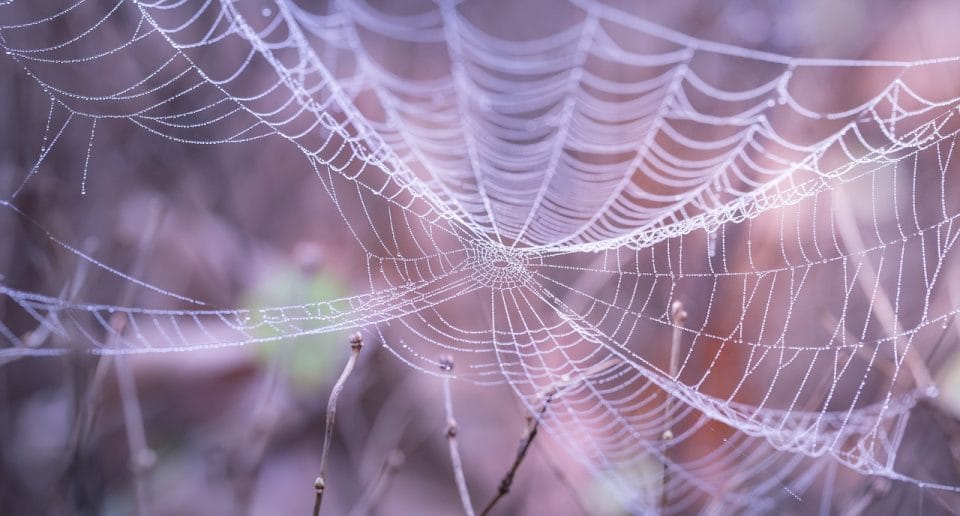Last Updated on March 9, 2021 by Editor Futurescope
The spider silk, flexible, light and very resistant, can be produced artificially, with applications in the medicine or the textile industry, according to the researchers. Silks are materials with a good bio compatibility and extraordinary mechanical properties as they possess great resistance and deformability. But not all silks are the same. Compared with the silk obtained from worms – mostly Bombyx mori – silk produced by spiders has significantly higher mechanical properties and is considered to be the natural fiber with the highest mechanical performance. This makes artificial spider silk excellent candidates as biomaterials in tissue engineering. However, unlike what happens in the case of worm silk, so far the spider silk has not been able to manufacture in an industrial way because spiders are animals of solitary and predatory nature, which makes it very difficult that grow in captivity.
The result of a long evolution, the silk produced by the glands of the spider is a fiber 30 times thinner than a hair and, at equal diameters, more solid than steel and resistant than Kevlar.
Its price is affordable and can be used for medical purposes since it does not provoke rejection.
Artificial spider silk could be used in regenerative medicine, but also in the textile industry for the manufacture of bulletproof vests, stronger and lighter fabrics, or for new models of sportswear.
An international scientific team involving researchers from the UPM (Universidad Politécnica de Madrid) has developed a new method to produce artificial spider silk, bio-inspired in natural spider silk, for the first time. But more resistant and cheap to obtain and with uses as diverse as textiles for shock absorption or advanced medical devices. it will be possible to spin artificial silk fibers as spiders do and efficiently produce kilometers of silk.
The work, published in Nature Chemical Biology and led by Jan Johansson and Anna Rising of the University of Agricultural Sciences in Sweden, has been carried out by scientists from the Polytechnic University of Madrid, China and the United Kingdom.
“Spider silk is a biodegradable and attractive material for many applications, because of its extraordinary capacity to absorb energy during its deformation to breakage and to be a biocompatible material,” explained Gustavo Plaza, a researcher at the Higher Technical School of Engineers of Roads, Channels and Ports of the Polytechnic and co-author of the work.
Artificial Spider Silk developed
But spider breeding is complicated because of their tendency to devour each other. In addition, its silk production, from the segregation of a protein solution, is very weak.
The researchers were able to design a “silk protein from various spider species,” said Jan Johansson of the Swedish University of Agricultural Sciences in Uppsala and co-author of the study published Monday in the journal Nature Chemical Biology.
According to the study, this artificial silk protein can be produced in large quantities.
“In 2009 and 2012, with great effort, years of dedication and silk spider extractions, they managed to weave two spider silk garments in Madagascar that were exhibited in museums in London and New York,” explains Gustavo Plaza.
Researchers have in particular developed a “spinning apparatus” that mimics their manufacturing process and “allows for the first time to produce endless artificial silk fibers,” Johansson said.
The silk of the spider is made up of large proteins. Within the silk glands of spiders, these proteins are kept in a highly concentrated solution. This solution passes through a narrow tube, in which the acidity changes, concentration increases and the material becomes insoluble fiber.
Inspired by the way spiders manufacture silk, Jan Johansson, Anna Rising and her colleagues developed a hybrid protein, which includes amino acid sequences present in the silks of two different spider species, in order to control the coagulation of Proteins, mimicking the process of natural spinning on the spiders themselves.
“In this method only water is used with solvent, varying the pH (that is, the acidity) to control the spinning process, so the material obtained does not have problems of biocompatibility”, underlines the researcher.
Spider silk is composed of proteins (spidroin) which, before spinning, remain stored as an aqueous solution in specific glands of the animal. Previous studies carried out by members of the research team, belonging to the University of Agricultural Sciences Of Sweden and the Karolinska Institute, showed that there is an important pH gradient in the silk glands. The regulation of this gradient affects specific parts of spider silk proteins and causes the fiber to form quickly at a particular location in the production apparatus. This has served to design an artificial silk spider protein that includes amino acid sequences of the spidroins of two different species. This chimeric protein has been shown to be as soluble in water as natural, allowing large amounts to be produced using bacteria to express them. In this way the production is scalable and therefore interesting from the industrial point of view.
To imitate the natural process that occurs in the spider silk gland, the research team, led by Professor Anna Rising, has built a very efficient spinning biomimetic system in which, only by reducing the pH, and with the help of the Voltages appearing in the spinning duct of the fibers, kilogram fibers can be obtained from the aqueous protein solution.
More information: http://ki.se/en/research/possible-to-spin-artificial-spider-silk
Researchers from the University of Uppsala (Sweden), the University of Lund (Sweden) and the Royal Institute of Technology KTH (Sweden), Donghua University (China) and Oxford University (United Kingdom).
Hard as steel
Contrary to what may seem, spider silk is extremely resistant. Experts consider that it can be compared to alloys as hard as steel. In addition, it has the ability to deform before breaking, which facilitates the absorption of energy. Hence one of the applications of artificial spider silk are bulletproof vests. It is also believed that this material could be used to make the threads used for suturing in surgical operations.
It is further believed that it would be possible to substitute other excised human tissues with spider webs to aid in the regeneration of the damaged area.
Stop a train
A study by a group of physics students at the University of Leicester showed that the famous scene in the movie Spiderman 2, in which a spider web for the running of a train, is theoretically possible.
The students calculated the maximum speed a train can reach on the New York subway.
To reach this conclusion, they first calculated the maximum speed reached by a New York subway train and concluded that a force of 300,000 Newtons would be needed to stop their four wagons.
They then estimated the resistance of the spider web, compared to that of the spiders. They concluded that the spider web offered a resistance of 3.12 gigapascals, something that matched that of weaver spiders, ranging from 1.5 to 12 gigapascals.
The truth is that certain natural materials such as spider silk could have uses for industry or technological innovation, so it is quite normal for scientists around the world to try to copy these types of elements to create them in mass artificially. And artificial spider silk allows to manufacture large quantities, also achieving that the production can be scalable and, therefore, industrial.







